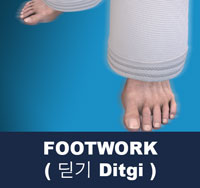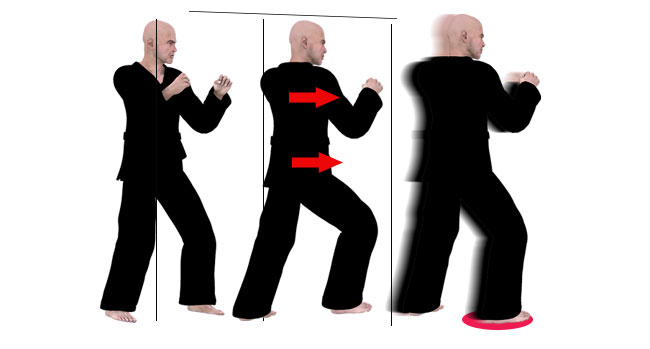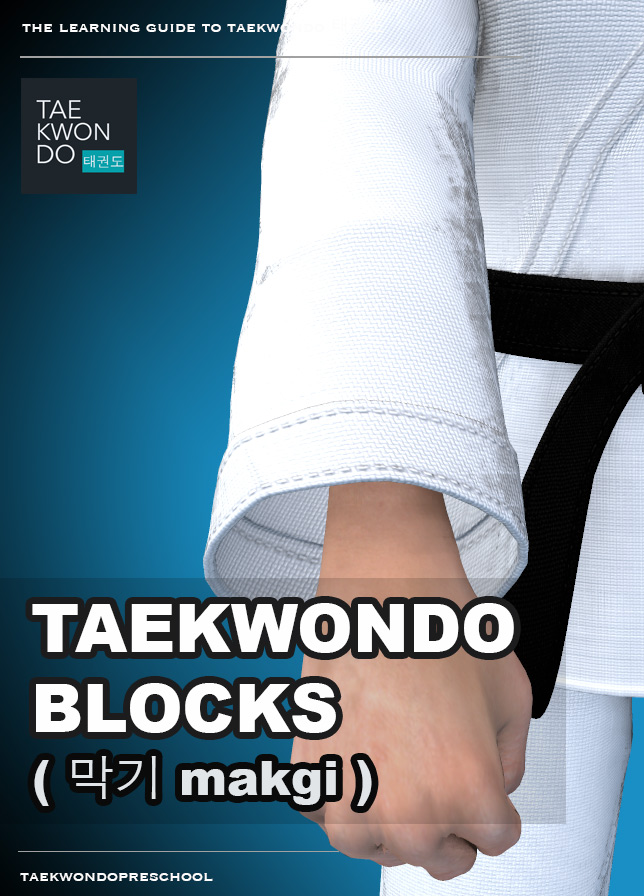Taekwondo 태권도Taekwondo Preschool
When you reach senior belt you are expected to guide the junior belts when they are beginning Taekwondo such as showing by example. To advance from one rank to the next, students typically complete promotion tests in which they demonstrate their proficiency in the various aspects of the art before a panel of judges or their teacher. View Taekwondo belt levels »

Footwork
( 딛기 ditgi )
Footwork involves keeping balance, closing or furthering the distance, controlling spatial positioning, and/or creating additional momentum for strikes.

Footwork ( 딛기 ditgi ) involves keeping balance, closing or furthering the distance, controlling positioning, and creating additional momentum for strikes. Dominated by the philosophy that the fastest and most economical way to an opponent is a straight line, taekwondo uses most often linear movement, and focus primarily on the speed of advance and retreat to overcome an adversary.
Linear Footwork
Linear movement is common to a great deal of the martial arts world, and is predominant in arts of Japanese and Korean influence such as the many forms of karate and taekwondo. Perhaps the most stark example of linear footwork, however, is that used in European fencing, especially within the modern sport aspect.
Dominated by the philosophy that the fastest and most economical way to an opponent is a straight line, arts that use linear movement as their focus adopt mostly rigid stances and behaviors, and focus primarily on the speed of advance and retreat to overcome an adversary.
The striking arts of Japan and Korea utilize linear form quickly to overwhelm opponents with powerful, focused blows, whereas the Chinese arts primarily respect linear movement as a method of staying in reference to the opponent's centerline, and for its necessary use in trapping, or close-range grappling exchanges.

Types of Footwork
- Stepping ( 딛기 ditgi )
- Forward Step ( 내딛기 nae-ditgi )
- Two-foot Forward Step ( 두발 내딛기 du-bal nae-ditgi )
- Rear Foot Forward Step ( 뒷발 내딛기 dwitbal-nae-ditgi )
- Front Foot Forward Step ( 앞발 내딛기 apbal-nae-ditgi )
- Turning Step ( 돌아딛기 dora-ditgi )
- Right Turn Step ( 오른 돌아딛기 oreun-dora-ditgi )
- Left Turn Step ( 왼 돌아딛기 wen-dora-ditgi )
- Back Turn Step ( 뒤 돌아딛기 dwi-dora-ditgi )
- Diagonal Step ( 모딛기 mo-ditgi )
- Right Backward Step ( 오른뒤 딛기 oreun-dwi-ditgi )
- Right Forward Step ( 오른앞 딛기 oreun-ap-ditgi )
- Left Backward Step ( 왼뒤 딛기 wen-dwi-ditgi )
- Left Forward Step ( 왼앞 딛기 wen-ap-ditgi )
- Backward Step ( 물러딛기 mulleo-ditgi )
- Two-foot Backward Step ( 두 발 물러딛기 du-bal mulleo-ditgi )
- Rear Foot Backward Step ( 뒷발 물러딛기 dwitbal-mulleo-ditgi )
- Front Foot Backward Step ( 앞발 물러딛기 apbal-mulleo-ditgi )
- Side Step ( 옆딛기 yeop-ditgi )
- Right Step ( 오른 딛기 oreun-ditgi )
- Left Step ( 왼 딛기 wen-ditgi )
- Stepping in Place ( 제자리딛기 jejari-ditgi )

Related Articles
Footwork ( 딛기 ditgi ) involves keeping balance, closing or furthering the distance, controlling positioning, and creating additional momentum for strikes. Dominated by the philosophy that the fastest and most economical way to an opponent is a straight line, taekwondo uses most often linear movement, and focus primarily on the speed of advance and retreat to overcome an adversary. View Footwork ( 딛기 ditgi ) »
- Forward Footwork ( 내딛기 nae-ditgi )
- Backward Footwork ( 물러딛기 mulleo-ditgi )
- Sideways Footwork ( 옆딛기 yeop-ditgi )
- Turning Step ( 돌아딛기 dora-ditgi )
- Diagonal Step ( 모딛기 mo-ditgi )
There are five tenets defined in the International Taekwondo Federation (ITF) and several more in World Taekwondo (WT).
Indomitable spirit ( 백절불굴 baekjul-boolgool ): "To have indomitable spirit means to have the courage to stand up for what you believe in, no matter what odds you are up against, and to always give 100% effort in whatever you do." View Taekwondo Tenets »
RESOURCES
This article uses material from the Wikipedia article "Footwork (Martial Arts)" which is released under the Creative Commons Attribution-Share-Alike License 3.0.






















